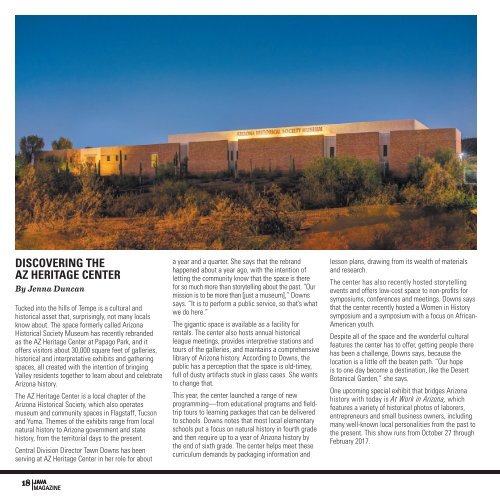Java.NOV.2016
Create successful ePaper yourself
Turn your PDF publications into a flip-book with our unique Google optimized e-Paper software.
DISCOVERING THE<br />
AZ HERITAGE CENTER<br />
By Jenna Duncan<br />
Tucked into the hills of Tempe is a cultural and<br />
historical asset that, surprisingly, not many locals<br />
know about. The space formerly called Arizona<br />
Historical Society Museum has recently rebranded<br />
as the AZ Heritage Center at Papago Park, and it<br />
offers visitors about 30,000 square feet of galleries,<br />
historical and interpretative exhibits and gathering<br />
spaces, all created with the intention of bringing<br />
Valley residents together to learn about and celebrate<br />
Arizona history.<br />
The AZ Heritage Center is a local chapter of the<br />
Arizona Historical Society, which also operates<br />
museum and community spaces in Flagstaff, Tucson<br />
and Yuma. Themes of the exhibits range from local<br />
natural history to Arizona government and state<br />
history, from the territorial days to the present.<br />
Central Division Director Tawn Downs has been<br />
serving at AZ Heritage Center in her role for about<br />
a year and a quarter. She says that the rebrand<br />
happened about a year ago, with the intention of<br />
letting the community know that the space is there<br />
for so much more than storytelling about the past. “Our<br />
mission is to be more than [just a museum],” Downs<br />
says. “It is to perform a public service, so that’s what<br />
we do here.”<br />
The gigantic space is available as a facility for<br />
rentals. The center also hosts annual historical<br />
league meetings, provides interpretive stations and<br />
tours of the galleries, and maintains a comprehensive<br />
library of Arizona history. According to Downs, the<br />
public has a perception that the space is old-timey,<br />
full of dusty artifacts stuck in glass cases. She wants<br />
to change that.<br />
This year, the center launched a range of new<br />
programming—from educational programs and fieldtrip<br />
tours to learning packages that can be delivered<br />
to schools. Downs notes that most local elementary<br />
schools put a focus on natural history in fourth grade<br />
and then require up to a year of Arizona history by<br />
the end of sixth grade. The center helps meet these<br />
curriculum demands by packaging information and<br />
lesson plans, drawing from its wealth of materials<br />
and research.<br />
The center has also recently hosted storytelling<br />
events and offers low-cost space to non-profits for<br />
symposiums, conferences and meetings. Downs says<br />
that the center recently hosted a Women in History<br />
symposium and a symposium with a focus on African-<br />
American youth.<br />
Despite all of the space and the wonderful cultural<br />
features the center has to offer, getting people there<br />
has been a challenge, Downs says, because the<br />
location is a little off the beaten path. “Our hope<br />
is to one day become a destination, like the Desert<br />
Botanical Garden,” she says.<br />
One upcoming special exhibit that bridges Arizona<br />
history with today is At Work in Arizona, which<br />
features a variety of historical photos of laborers,<br />
entrepreneurs and small business owners, including<br />
many well-known local personalities from the past to<br />
the present. This show runs from October 27 through<br />
February 2017.<br />
18 JAVA<br />
MAGAZINE


















